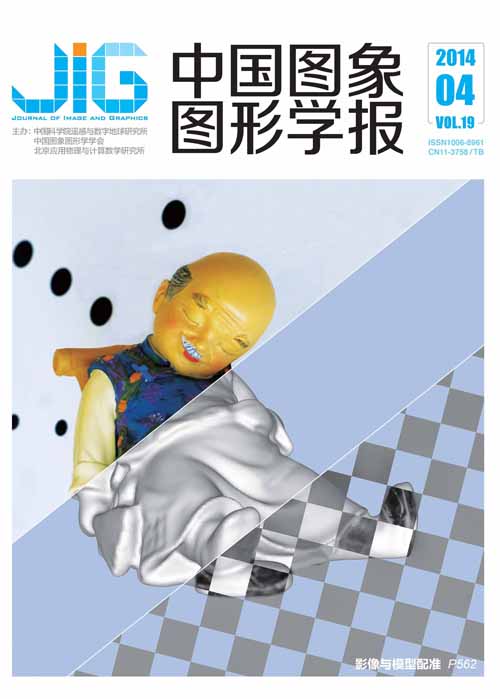
小物体3维重建中影像与几何模型的配准
摘 要
目的 近景摄影测量中的目标几何形状复杂,且拍摄影像的角度变化大,给影像与几何模型的配准带来了困难。传统单幅影像与几何模型配准的做法,由于缺乏自动粗配准的方法,效率相对较低。将多视影像首先统一坐标系的做法,在近景目标的复杂背景下也难以实现。方法 为此,将近景目标置于平面标定板上,利用相机标定的方法同时解算出影像的内外方位元素,实现多视影像坐标系的统一。然后人工选取3组以上同名点,做多视影像与几何模型的绝对定向,得到初始配准参数。最后使用多视影像与几何模型漫反射渲染图之间的归一化互信息作为相似性测度,用Powell非线性优化方法得到配准参数的精确值。结果 实验结果表明,使用标定板可以稳定地获取多视影像的内外方位元素,用绝对定向得到的配准参数进行影像和几何模型的交替显示仍然可以看到明显的裂缝,在经过互信息优化后裂缝现象得到明显改善。结论 多视影像与几何模型配准相比传统单幅影像与几何模型配准,人工选取同名点的工作量大大减少,由于人工选点存在误差,影响绝对定向的精度,使用归一化互信息作为测度进行非线性优化,可以获得更高的精度。
关键词
Images and geometric model registration in 3D reconstruction of small objects
Zheng Shunyi, Wang Xiaonan(School of Remote Sensing and Information Engineering, Wuhan University, Wuhan 430079, China) Abstract
Objective Because the digitalization of real objects often entails the texture mapping of the 3D geometry model, images-to-geometry registration is indispensable.The geometry of the target in close-range photogrammetry is complex, and the shooting angle of the image changes largely, which makes images-to-geometry registration difficult to process. Traditionally, a single image is registered with a geometric model by manually selecting the corresponding points. Thus for tens of images this processing can be very time consuming. For efficiency, the position and orientation of the multi-view images can be unified in one coordinate system at first. However, this process is also difficult because of the complex and uncertain background in close-range photogrammetry. Method To this end, we put a plane calibration board under the target while taking images, and use the camera calibration to get both, the internal and external orientation parameters; thus, the multi-view imagesare placed in one coordinate system. The unified coordinate system means when the registration parameters of one image are known, the registration parametersof all other images can be calculated through the relative positions and orientations among them. Then, at least three groups of corresponding points are manually selected, and the registration parameters are calculated by using the absolute orientation. The achieved registration parameters are not precise enough but can be used as an initial value. Finally, by making the normalized mutual information between multi-view images and the diffuse rendered maps of the geometric modelas a similarity measure, we use Powell's nonlinear optimization method to get the precise registration parameters.In the final process, we optimize all images together, while the traditional methods optimize each single image separately; the difference is we have only 7 parameters for all images, but the traditional methods have 7 parameters for each image. Result The experimental results show that using the calibration board we obtain robust internal and external orientation parametersof multi-view images, and after the absolute orientation process, we find obvious gaps between the images and the rendered maps. However, after a normalized mutual information based optimization process, the gaps are significantly improved.The typical total registration work takes about 10 minutes, in which there are 4 minutes for manual work and 6 minutes for computation; by contrast, the fully manual texture-mapping work by using the commercial software-Cinema4D takes nearly 4 hours. Conclusion Registration between multi-view images and geometric model compared to registration between single image and geometric model, the workload of manually selecting corresponding points is greatly reduced.The errors of manually selected points can affect the accuracy of absolute orientation, but after using normalized mutual information based nonlinear optimization, we can still get precise registration parameters. The normalized mutual information based nonlinear optimization can also be used for single image-to-geometry registration, but for multi-view images the method is more robust. The optimization method has one drawback: it requires the geometric model has a high quality. This is because the normalized mutual information has a close relationship to the surface's normal vector of the geometric model. This drawback can be avoided by using high accurate 3D scanners.
Keywords
|



 中国图象图形学报 │ 京ICP备05080539号-4 │ 本系统由
中国图象图形学报 │ 京ICP备05080539号-4 │ 本系统由